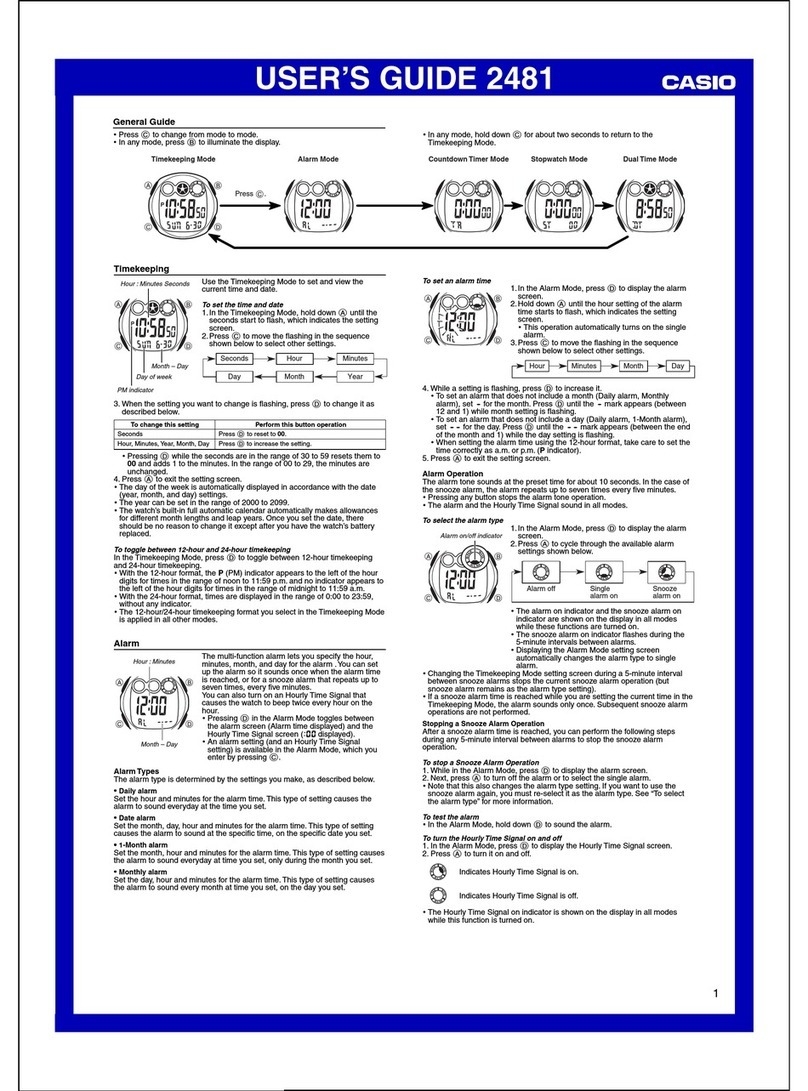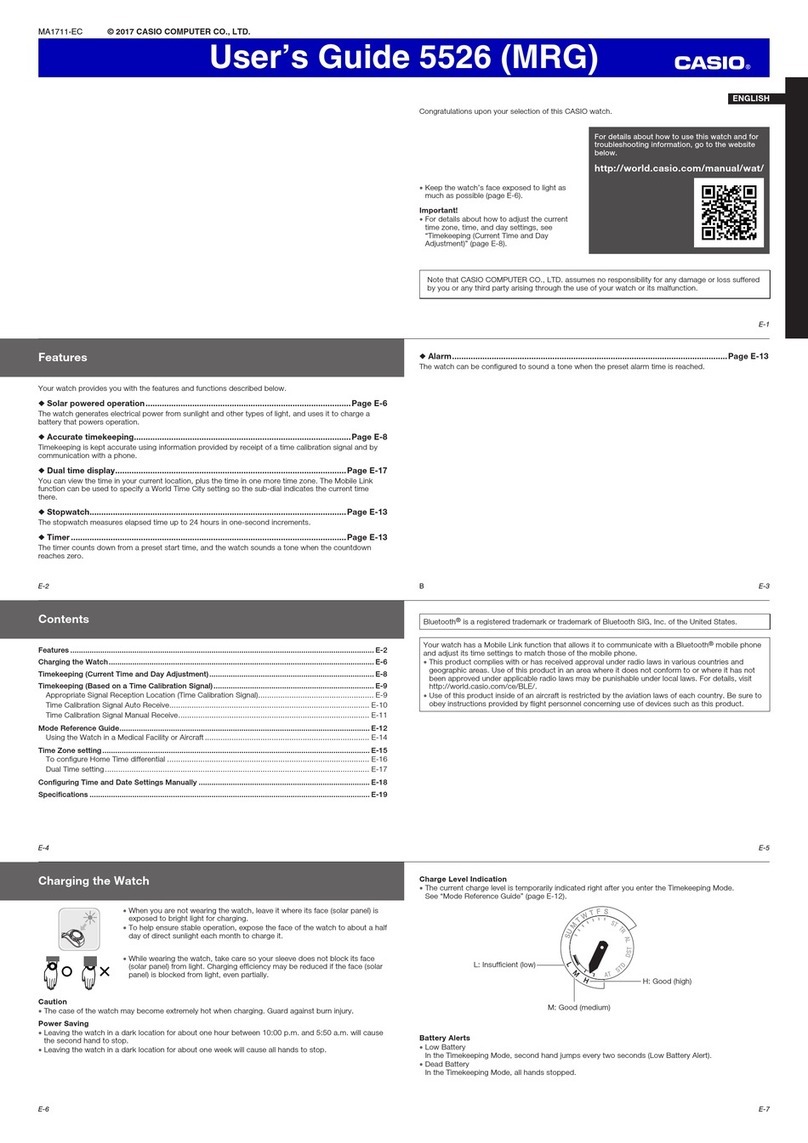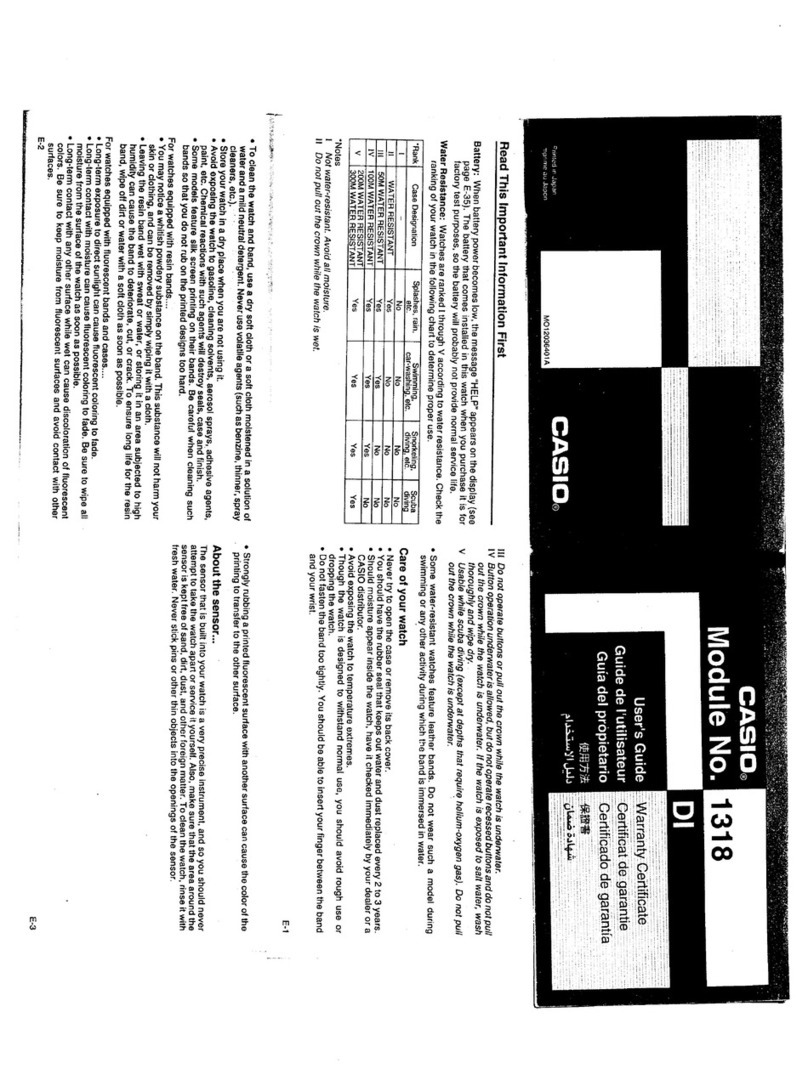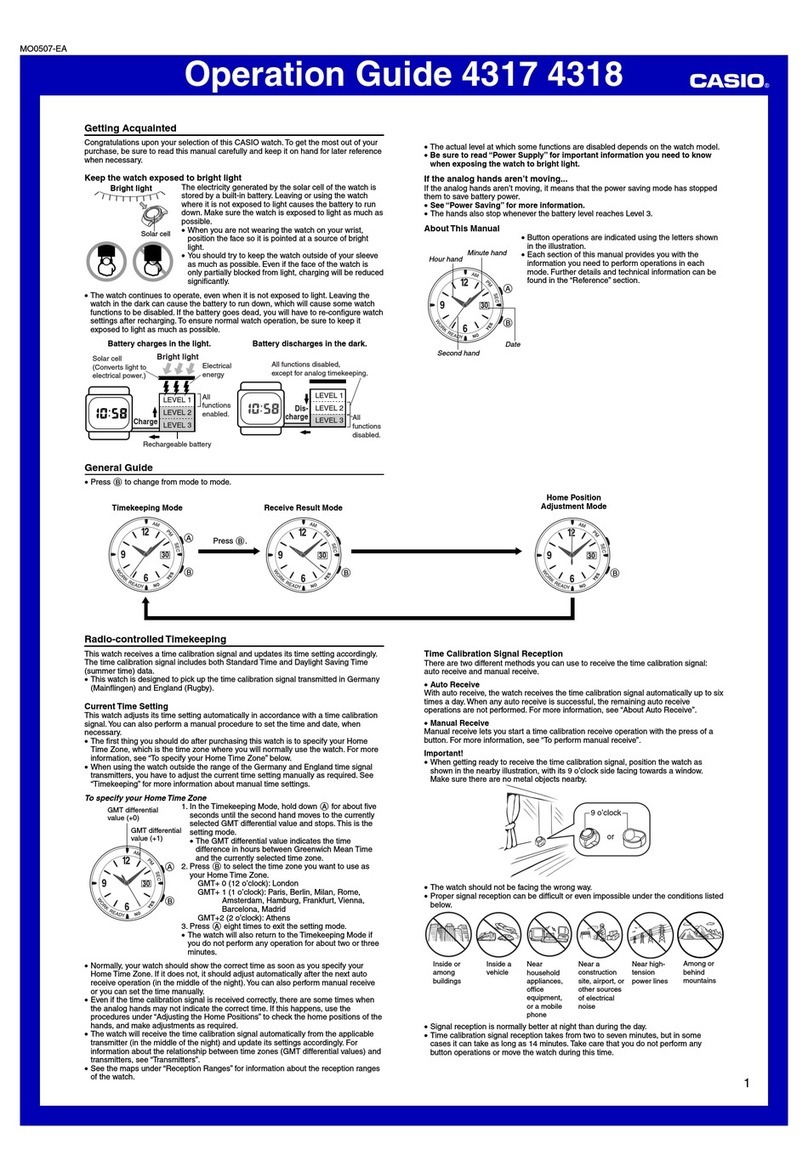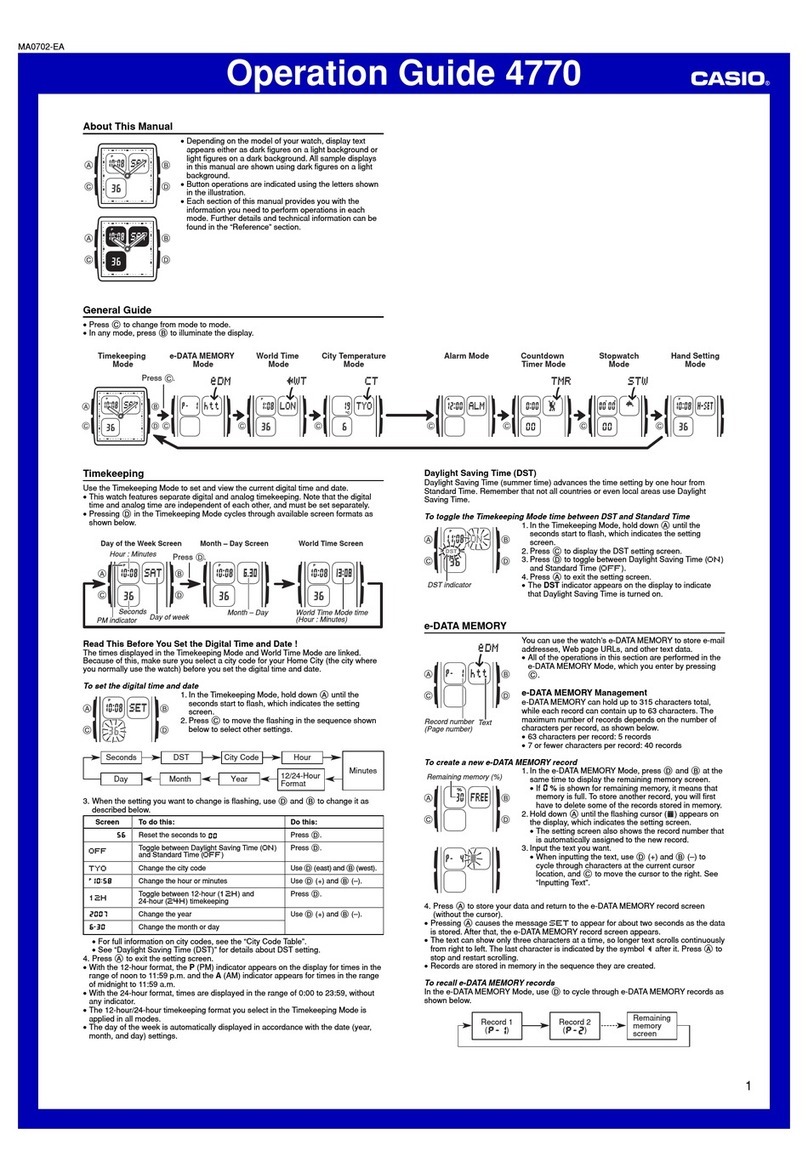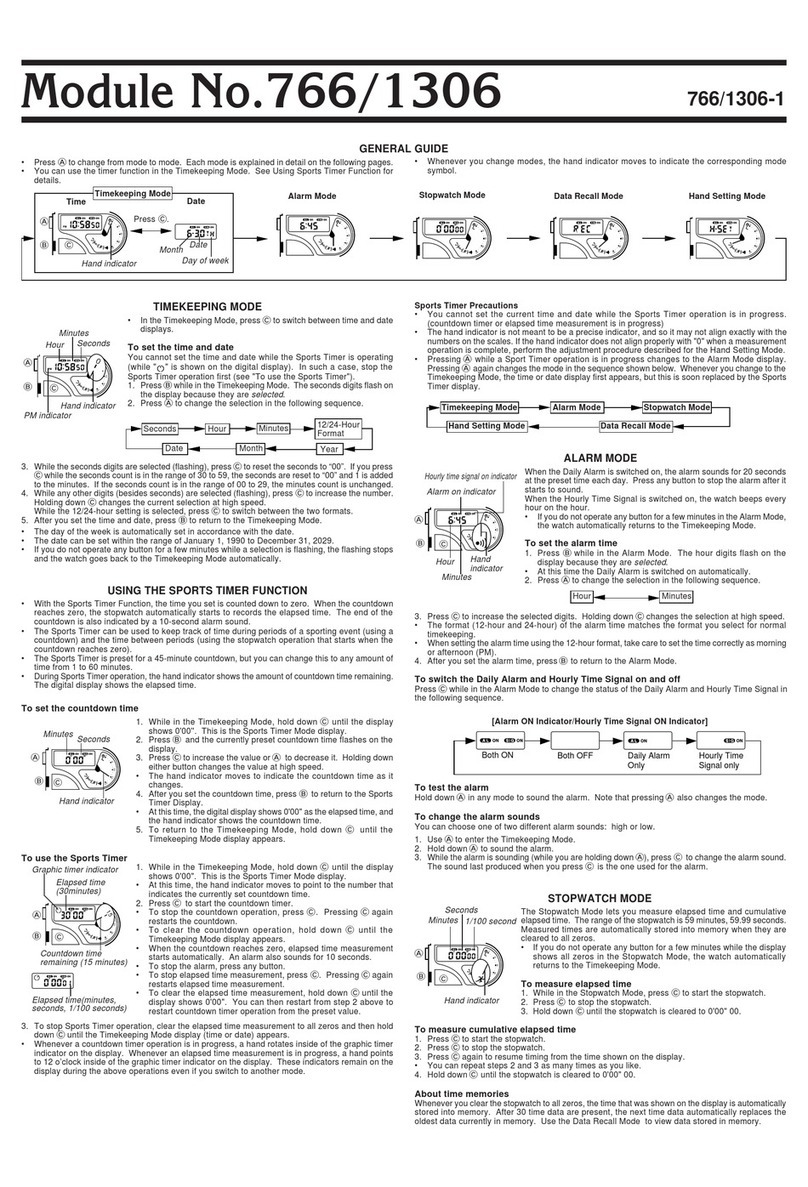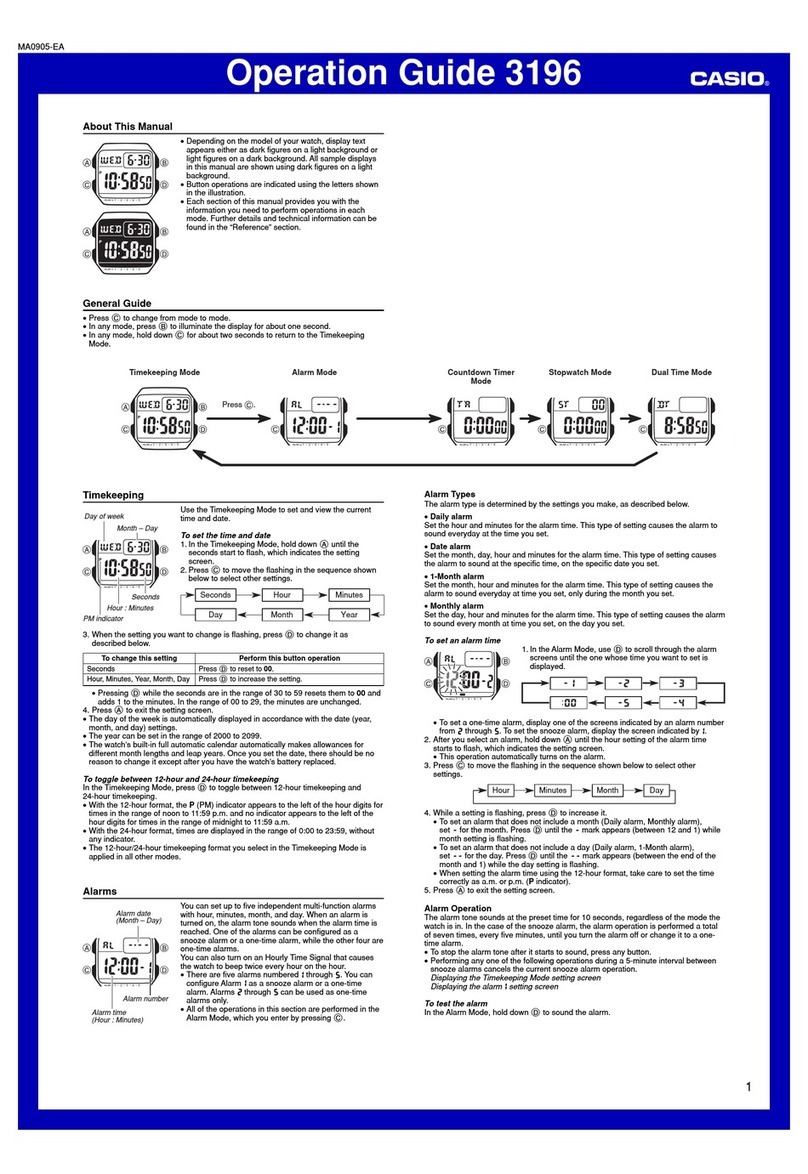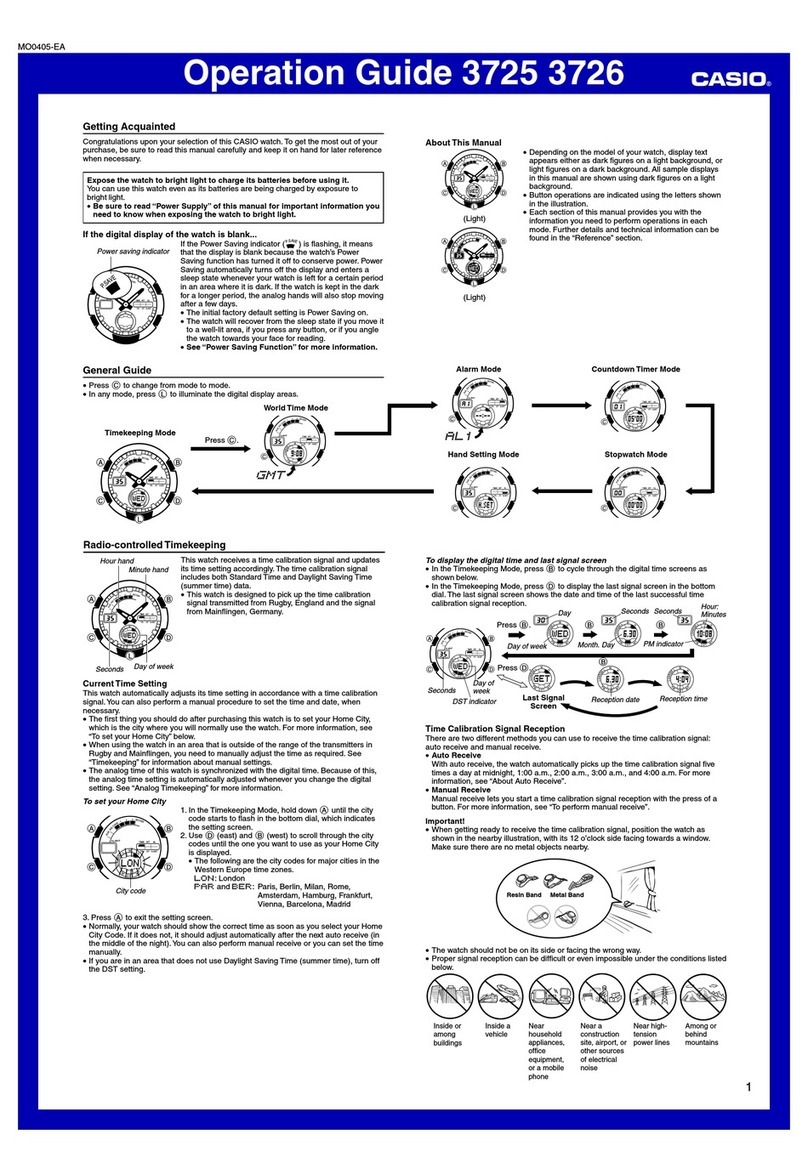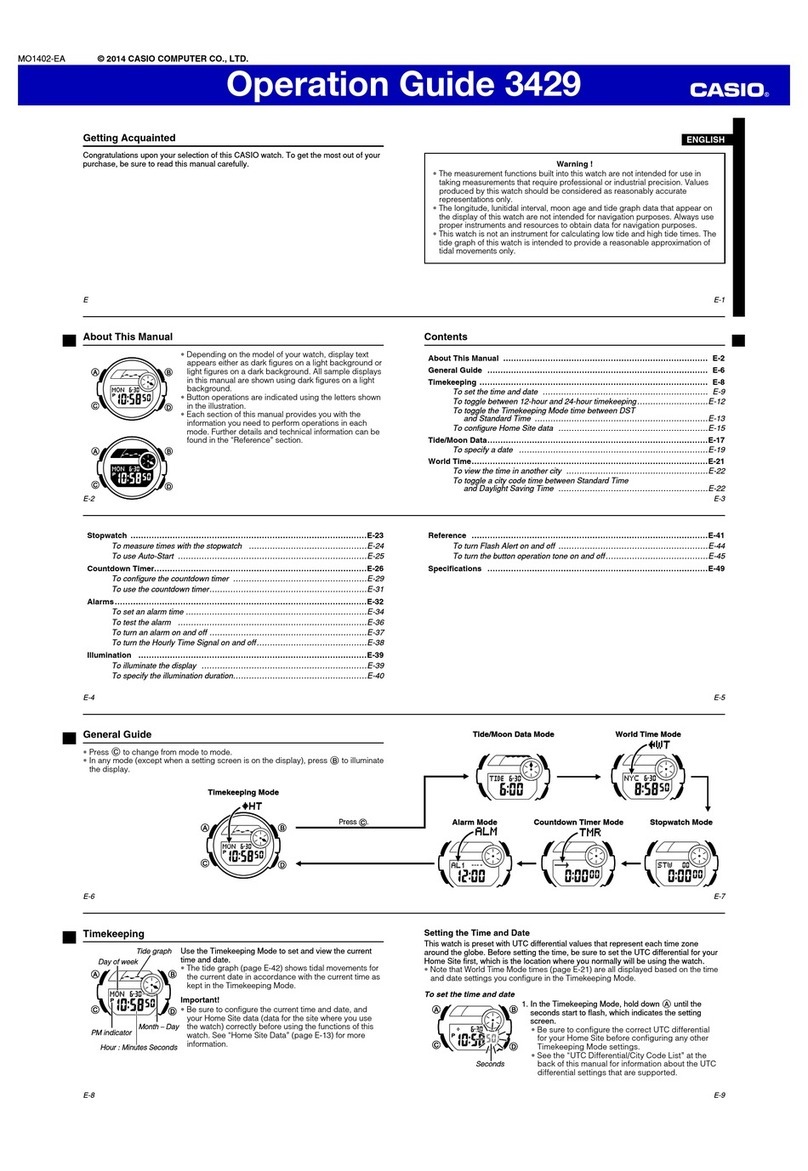
Operation Guide 5046
4
Battery Power Levels
The movement of the analog hands indicates the current battery power level.
Jumps two seconds
Hand Movement
Normal.
•Second hand jumps
every 2 seconds.
•Date changes to home
position.
•Second hand stopped.
•Hour and minute hands
stopped at 12 o’clock.
Level
1
2
3
Function Status
All functions enabled.
Time calibration signal
reception disabled.
All functions disabled.
•The second hand jumping every two seconds (Level 2) indicates that battery power
is quite low. Expose the watch to light as soon as possible to charge the battery.
•When battery power is at Level 2, time calibration signal reception is disabled.
•At Level 3, all functions are disabled and settings return to their initial factory
defaults. The watch will continue to keep time internally for about one month after the
battery drops to Level 3. If you recharge the battery sufficiently during this period,
the analog hands will move automatically to the correct setting and normal
timekeeping will resume.
•The watch’s Home Time Zone setting will change automatically to +9 (Tokyo)
whenever the battery drops to Level 3. With this Home Time Zone setting, the watch
is configured to receive the time calibration signals of Japan. If you are not in Japan,
you will need to use the procedure under “To specify your Home Time Zone” to
change the Home Time Zone setting to your current location whenever the battery
drops to Level 3.
Charging Precautions
Certain charging conditions can cause the watch to become very hot. Avoid leaving
the watch in the areas described below whenever charging its rechargeable battery.
Warning!
Leaving the watch in bright light to charge its rechargeable battery can cause it
to become quite hot. Take care when handling the watch to avoid burn injury.
The watch can become particularly hot when exposed to the following
conditions for long periods.
•On the dashboard of a car parked in direct sunlight
•Too close to an incandescent lamp
•Under direct sunlight
Charging Guide
After a full charge, timekeeping remains enabled for up to about five months.
•The following table shows the amount of time the watch needs to be exposed to light
each day in order to generate enough power for normal daily operations.
Exposure Level (Brightness)
Outdoor sunlight (50,000 lux)
Sunlight through a window (10,000 lux)
Daylight through a window on a cloudy day
(5,000 lux)
Indoor fluorescent lighting (500 lux)
Approximate Exposure Time
8 minutes
30 minutes
48 minutes
8 hours
•For details about the battery operating time and daily operating conditions, see the
“Power Supply” section of the Specifications.
•Stable operation is promoted by frequent charging.
Recovery Times
The table below shows the amount exposure that is required to take the battery from
one level to the next.
25 hours
92 hours
– – –
– – –
Outdoor sunlight (50,000 lux)
Sunlight through a window
(10,000 lux)
Daylight through a window on
a cloudy day (5,000 lux)
Indoor fluorescent lighting
(500 lux)
Approximate Exposure Time
Level 3 Level 2 Level 1
2 hours
6 hours
9 hours
101 hours
Exposure Level
(Brightness)
▲
▲
•The above exposure time values are all for reference only. Actual required exposure
times depend on lighting conditions.
Reference
This section contains more detailed and technical information about watch operation.
It also contains important precautions and notes about the various features and
functions of this watch.
Auto Return Features
•If you leave the watch in the home position adjustment mode for two or three
minutes without performing any operation, it will return to the Timekeeping Mode
automatically.
•If you do not perform any operation for about two or three minutes while a setting
mode is selected, the watch will exit the setting mode automatically.
High-Speed Movement
•The Dand Bbuttons are used to change the hand setting in various setting
modes. In most cases, holding down these buttons will start high-speed movement
of the applicable hand(s) and day.
•High-speed movement of hands and day will continue until you press any button, or
until the moving hand(s) and day finishes one complete cycle.
- One complete cycle for the hands is one revolution (360 degrees) of the hour
hand, or 24 hours.
- One complete cycle for the day is 31 days.
Radio-controlled Atomic Timekeeping Precautions
•Strong electrostatic charge can result in the wrong time being set.
•The time calibration signal bounces off the ionosphere. Because of this, such factors
as changes in the reflectivity of the ionosphere, as well as movement of the
ionosphere to higher altitudes due to seasonal atmospheric changes or the time of
day may affect the reception range of the signal and make reception temporarily
impossible.
•Even if the time calibration signal is received properly, certain conditions can cause
the time setting to be off by up to one second.
•The current time setting in accordance with the time calibration signal takes priority
over any time settings you make manually.
•The watch is designed to update the date and day of the week automatically for the
period January 1, 2000 to December 31, 2099. Setting of the date by the time
calibration signal will not be performed starting from January 1, 2100.
•This watch can receive signals that differentiate between leap years and non-leap
years.
•Though this watch is designed to receive both time data (hour, minutes, seconds)
and date data (year, month, day), certain signal conditions can limit reception to time
data only.
•If you are in an area where proper time calibration signal reception is impossible, the
watch keeps time with the precision noted in “Specifications”.
Transmitters
The time calibration signal received by this watch depends on the currently
selected Home Time Zone.
•When a U.S. time zone is selected, the watch receives the time calibration signal
transmitted from the United States (Fort Collins).
•When a Japanese time zone is selected, the watch receives the time calibration
signal transmitted from Japan (Fukushima and Fukuoka/Saga).
•When a European time zone is selected, the watch receives the time calibration
signals transmitted from Germany (Mainflingen) and England (Anthorn).
•When a China time zone is selected, the watch receives the time calibration signals
transmitted from China (Shangqiu City).
•When your Home Time zone is +0, +1, +2 (which can receive both the Anthorn and
Mainflingen signals), the watch first tries to pick up the signal it last successfully
received. If that fails, it tries the other signal. For the first receive after you select your
Home Time zone, the watch tries the nearest signal first (Anthorn for +0,Mainflingen
for +1 and +2).
Timekeeping
•The year can be set in the range of 2000 to 2099.
•The watch’s built-in full automatic calendar makes allowances for different month
lengths and leap years. Once you set the date, there should be no reason to change
it except after you have the watch’s battery replaced or when battery power drops to
Level 3.
•The date will change automatically when the current time reaches midnight. The
date change at the end of the month may take more time than normal.
•The current time for all time zones in the Timekeeping Mode is calculated in
accordance with the UTC offset of each time zone, based on your Home Time Zone
setting.
•UTC offset is calculated by this watch based on Coordinated Universal Time (UTC*)
data.
*
UTC is the world-wide scientific standard of timekeeping. It is based upon carefully
maintained atomic (cesium) clocks that keep time accurately to within microseconds.
Leap seconds are added or subtracted as necessary to keep UTC in sync with the
Earth’s rotation. The reference point for UTC is Greenwich, England.
Power Saving
Power Saving enters a sleep state automatically whenever the watch is left for a
certain period in an area where it is dark. The table below shows how watch functions
are affected by Power Saving.
•There actually are two sleep state levels: “second hand sleep” and “function sleep”.
Operation
Second hand only is stopped, all other functions are
enabled.
•All functions, including analog timekeeping, disabled
•Internal timekeeping maintained
Elapsed Time in Dark
60 to 70 minutes
(second hand sleep)
6 or 7 days
(function sleep)
•Wearing the watch inside the sleeve of clothing can cause it to enter a sleep state.
•The watch will not enter a sleep state between 6:00 AM and 9:59 PM. If the watch is
already in a sleep state when 6:00 AM arrives, however, it will remain in that sleep
state.
To recover from a sleep state
Perform any one of the following operations.
•Move the watch to a well-lit area.
•Press any button.
Specifications
Accuracy at normal temperature: ± 15 seconds a month (with no signal calibration)
Timekeeping: Hour, minutes (hand moves every 10 seconds), seconds, day
Calendar system: Full Auto-calendar pre-programmed from the year 2000 to
2099
Other: Home Time Zone (can be assigned one of 9 time zones); FREE (signal
receive disabled)
Time Calibration Signal Reception: Auto receive up to six times a day (five times for
the China signal) (Remaining auto receives cancelled as soon as one is
successful); Manual receive
Receivable Time Calibration Signals:
Mainflingen, Germany (Call Sign: DCF77, Frequency: 77.5 kHz); Anthorn,
England (Call Sign: MSF, Frequency: 60.0 kHz); Fort Collins, Colorado,
the United States (Call Sign: WWVB, Frequency: 60.0 kHz); Fukushima,
Japan (Call Sign: JJY, Frequency: 40.0 kHz); Fukuoka/Saga, Japan (Call
Sign: JJY, Frequency: 60.0 kHz); Shangqiu City, Henan Province, China
(Call Sign: BPC, Frequency: 68.5 kHz)
Other: Power Saving
Power Supply: Solar cell and one rechargeable battery
Approximate battery operating time: 6 months (from full charge to Level 3) under
the following conditions:
•Watch is not exposed to light
•Internal timekeeping
•Analog hands operational 18 hours per day, sleep state 6 hours per day
•4 minutes of signal reception per day

